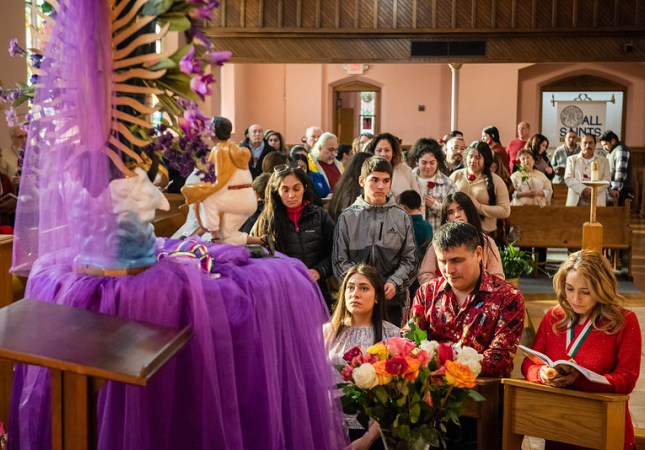
Above: Faithful pray and place roses beneath a statue of Our Lady of Guadulupe on Dec. 12 at St. Boniface Church (All Saints Parish) in Bay City
View photos from Novena Mass at All Saints Parish, Bay City
View photos from Novena Mass at St. Francis of Assisi Parish in Saginaw
View photos from Novena Mass at St. Joseph Parish in Saginaw
The annual novena to Our Lady of Guadalupe is more than a series of Masses and prayers. For many Hispanic Catholics, it is an expression of deep love and devotion for our Blessed Mother and a tradition that goes back generations.
Julia Velasquez, a member of All Saints Parish in Bay City, remembers attending the novena at St. Joseph Parish in Bay City (now part of St. Jude Thaddeus) with her parents as a child and later at Our Lady of Guadalupe Parish in Bay City (which has since merged with All Saints.)
“We were brought up going to the novena with my parents, and I just carry this tradition with my children,” she said.
Together with her children and grandchildren, Julia knelt before a statue of Our Lady of Guadalupe to offer prayers and roses during the mañanitas serenade on Dec. 12 at All Saints Parish, St. Boniface Church.
“To have her here and to have the young ones and all of us here to see her, you really can’t put into words what you feel for her. In our culture, Virgencita is so special,” she said. “She is our Mother … She is the Mother who brings us together, the Mother of peace, the Mother who will never leave us, the Mother of all.”
St. Francis of Assisi and St. Joseph Parishes, both in Saginaw, also hosted novenas. Each day from Dec. 4 through 12, Faithful gather to pray the Rosary and celebrate Mass. After last year’s hiatus, the festive gatherings with Mexican chocolate and pan dulce (sweet bread) followed each Mass.
Traditionally, the mañanitas serenades to Our Lady would begin at midnight on Dec. 11 as a way of welcoming the Feast Day of Our Lady of Guadalupe, but mañanitas are now sometimes sung during the day or Mass. Men, women and children offered roses to her and knelt in prayer, some with tears in their eyes as they sang to their Mother.
The feast day commemorates the final apparition of the Virgin Mary to St. Juan Diego Cuauhtlatoatzin, an indigenous Mexican. During this final apparition, she requested Juan Diego gather roses in his tilma (cloak) and bring them to Bishop Juan de Zumárraga. When he opened the tilma, the roses fell to reveal the miraculous image of Our Lady of Guadalupe. Over the next few years, millions of indiginous people and European immigrants, especially the Spaniards, were converted to Catholicism.
“The Catholic Church has universally attributed a special piety to the Virgin Mary, Mother of God. The piety to Mary under the title of Our Lady of Guadalupe is based upon the Christian history of Mexico and the support Our Lady has given to the evangelization of the Church throughout the North American continent, if not the world,” said Deacon Librado (Larry) Gayton, director of multicultural ministry for the Diocese of Saginaw. “Our Lady of Guadalupe continues to lead new generations of families to her son, Jesus Christ. Que maravilla!”
Faithful were able to pray with the parishes hosting the novena, as well as participate via livestream on St. Joseph Parish of Saginaw’s Facebook page.
A joyful return
“After a long stretch of dealing with public health concerns, this year, it was amazing that people returned to pray our Novena to Our Lady of Guadalupe in parishes throughout our Diocese. I was overjoyed to see people in substantial numbers in the parishes that I was able to visit during the Novena Masses. Some parishes had 200 to 300 in attendance!” Deacon Larry said. “I also want to thank Father Alberto Vargas, Father José María Cabrera and Father Frank Voris for allowing me to celebrate this novena with their parishes and all the priests and organizers that helped.”
Back at All Saints Parish, the cry and response “¡Viva que Virgen de Guadalupe!” “¡Que viva!” rang out in joyful celebration in honor of Our Lady.
“If you ever go into any kind of Hispanic home, you’ll always find the Virgencita,” said Monica Garza, the daughter of Julie Velasquez. Monica held out the medal of Our Lady of Guadalupe she received for her quinceñera. “She will always protect you. She will always look over us.”
“She’s the mother of all mothers, and she’s the mother of the poor,” Monica continued. “You may not think you have everything, but with her, you’re a millionaire. … We’ll never be alone.”
For Hispanic Catholics like Julie, the chance to share their devotion to the Virgin Mary and their Mexican heritage is a special grace.
“Our Virgencita is not just here with us. (The devotion) has spread around the world,” she said. “They all know Our Lady of Guadalupe.”
Note: When Dec. 12 falls on a Sunday (in 2021, 2027, 2032, 2038, etc.), the Feast of Our Lady of Guadalupe is not liturgically celebrated that year, though the Diocesan Bishop may make alternative provisions to honor Our Lady of Guadalupe. Consult your diocesan liturgical office for more information.